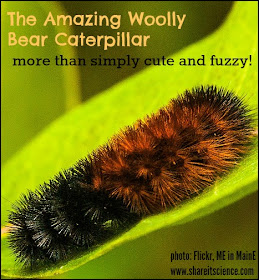 |
| (source) |
This post may contain affiliate links, meaning I make a small commission from purchases made through these links at no additional cost to you. See disclosures for more details.
 |
| Woolly Bear By Micha L. Rieser (Own work) [CC BY-SA 4.0], via Wikimedia Commons |
Woolly Bear Caterpillar Folklore
A common bit of folklore in the United States is that this
caterpillar can help predict the weather! Just like Punxsutawney Phil
predicts the length of winter, people believe that the width of the
different bands on the caterpillar's bristly body indicate the
severity of the winter. The myth goes something like this: the wider
the brown/copper colored band in the middle is, the milder the
winter. There are variations of this story, but that is the most pervasive.
This idea was made even more popular in 1948 by a study by Howard Curran, a curator of Entomology at the American Natural History Museum. Curran went to Bear Mountain State Park in NY with several other scientists and collected 15 woolly bear specimens. The study indicated that there was a correlation with the size of the bands and the winter weather. Curran continued the study for several more years. Although at the time the results were popular, further research of much larger sample sizes indicates that there is simply too much variability in individuals of these caterpillars for their predictive powers to be true. Although they might not be able to predict winter weather, they are the stars of many festivals and events, including the Woolly Bear Festival in Vermillion, Ohio and the Woolly Worm Festival in Banner Elk, North Carolina.
This idea was made even more popular in 1948 by a study by Howard Curran, a curator of Entomology at the American Natural History Museum. Curran went to Bear Mountain State Park in NY with several other scientists and collected 15 woolly bear specimens. The study indicated that there was a correlation with the size of the bands and the winter weather. Curran continued the study for several more years. Although at the time the results were popular, further research of much larger sample sizes indicates that there is simply too much variability in individuals of these caterpillars for their predictive powers to be true. Although they might not be able to predict winter weather, they are the stars of many festivals and events, including the Woolly Bear Festival in Vermillion, Ohio and the Woolly Worm Festival in Banner Elk, North Carolina.
Amazing Winter Adaptations of Woolly Bear Caterpillars
The really fascinating fact about these
caterpillars is their ability to weather the winter months by
freezing themselves solid. Their bodies actually break certain parts
down and begin to produce glycerol, which works as an "anti-freeze"
to prevent cell damage. The structure of their bristly hair, or
setae, allows them to begin freezing on the outside before their
bodies freeze.
Pretty amazing, right? To learn more about these incredible
insects, check out the resources and book suggestions below!
Children are drawn to caterpillars. You should be cautious with fuzzy ones as handling them can be irritating to the skin. Woolly bears hairs are not as harmful as other fuzzy species, but they can still break off in the skin and be irritating. It is a good idea to have a "look, don't touch" policy with these at home or in the classroom.
Although all woolly bear caterpillars,
or Pyrrharctia isabella, are
capable of weathering freezing temperatures, the ones that live in the Arctic
are the most amazing. Due to short periods of warm weather, the caterpillar
will go through this freezing and thawing process up to 14 times (in
other words, 14 years) before it makes a cocoon and emerges as an
adult Isabella Tiger moth!
 |
| Pyrrharctia isabella – Isabella Tiger Moth By Andy Reago & Chrissy McClarren [CC BY 2.0], via Wikimedia Commons |
Woolly Bear Activities with Kids
When learning about adaptations and temperature you can investigate ectotherms (cold-blooded animals) by building them with heat-sensitive play dough.
Open ended learning ideas with woolly bear caterpillars in the classroom.
Read more:
- Weather.gov: "Woolly Bear Caterpillar- Weather Predictor or Not?"
- Scientific American Blog: "Arctic Creepy-Crawlies Part II: Woolly Bear Caterpillars"
- Old Farmers Almanac: "Predicting Winter Weather- Woolly Bear Caterpillars"

No comments:
New comments are not allowed.